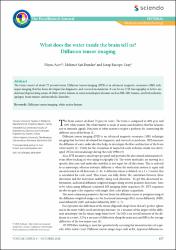| dc.contributor.author | Acer, Niyazi | |
| dc.contributor.author | Dundar, Mehmet Sait | |
| dc.contributor.author | Bastepe-Gray, Serap | |
| dc.date.accessioned | 2019-06-26T05:58:43Z | |
| dc.date.available | 2019-06-26T05:58:43Z | |
| dc.date.issued | 2018 | en_US |
| dc.identifier.citation | The EuroBiotech Journal Volume 2: Issue 4 Page Count: 177–179 DOI: https://doi.org/10.2478/ebtj-2018-0047 | en_US |
| dc.identifier.issn | 2564-615X | |
| dc.identifier.other | Accession Number: WOS:000467981700001 | |
| dc.identifier.uri | http://acikerisim.agu.edu.tr/xmlui/handle/20.500.12573/37 | |
| dc.description.abstract | The brain consist of about 75 percent water. Diffusion tensor imaging (DTI) is an advanced magnetic resonance (MR) technique imaging that has been developed for diagnostic and research in medicine. It can be use DTI tractography to better understand degenerating axons of white matter lesions in some neurological diseases such as MS, AD, trauma, cerebral ischemia, epilepsy, brain tumors and metabolic disorders. | en_US |
| dc.language.iso | eng | en_US |
| dc.publisher | SCIENDO, DE GRUYTER POLAND SP Z O O, BOGUMILA ZUGA 32A STR, 01-811 WARSAW, POLAND | en_US |
| dc.rights | info:eu-repo/semantics/openAccess | en_US |
| dc.subject | Diffusion tensor imaging | en_US |
| dc.subject | white matter lesions | en_US |
| dc.title | What does the water inside the brain tell us? Diffusion tensor imaging | en_US |
| dc.type | article | en_US |
| dc.contributor.department | AGÜ, Mühendislik Fakültesi, Elektrik & Elektronik Mühendisliği Bölümü | en_US |
| dc.contributor.institutionauthor | | |
| dc.relation.publicationcategory | Makale - Uluslararası Hakemli Dergi - Kurum Öğretim Elemanı | en_US |


















